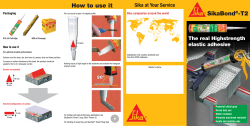
Area Elastic v Point Elastic
Sports Flooring Information Area Elastic v Point Elastic www.dynamiksportsfloors.co.uk AREA ELASTIC v POINT ELASTIC What are the Characteristics of an Area Elastic or Point Elastic Sports Floor? We are often asked why choose an area elastic sports floor over a point elastic sports floor system. Below we illustrate the three types of sports floor system and briefly describe their characteristics with regard to shock absorption and vertical deformation – these are key elements for the protection of an athlete playing on a sports floor system and reduce the risk of injury. AREA ELASTIC Area elastic floors deflect any impact over a much wider area and have much greater shock absorption and vertical deformation than a typical point elastic system. POINT ELASTIC COMBINED ELASTIC Point elastic systems have less shock absorption as the deflection only occurs at or close to the point of impact and little vertical deformation occurs. An area-elastic floor combined with a point-elastic top layer. Applying a point force causes both localised deflection and deflection over a wider area. Typical construction of a Point Elastic and Area Elastic Sports Floor System POINT ELASTIC AREA ELASTIC n n n n n Point Elastic Latex Epoxy DPM Screed to +/- 3mm over 3m Ground Bearing Slab A point elastic system comprises either a rubber pad finished with seamless polyurethane or a dense foam finished with a cushioned vinyl. The thickness can vary between 7mm and 16mm, depending on the desired performance. A point elastic system must be installed onto a level subfloor (+/- 3mm over 3m). n n n n n n 22mm Engineered Board 15mm Plywood Beam 10mm Foam Packing to Suit Void Damp Proof Membrane Ground Bearing Slab An area elastic system can be constructed in 2 ways, the most popular is using a beam system. The system can also be finished with a choice of timber or synthetic surfaces. An area elastic system can be installed with underfloor heating and on an even subfloor. 0117 301 5120 | www.dynamiksportsfloors.co.uk AREA ELASTIC v POINT ELASTIC Cost Comparison between Area Elastic and Point Elastic Sports Floor Systems Although perceived to be much cheaper a point elastic sports floor system can actually work out more expensive than a good quality area elastic sports floor system. As noted previously a point elastic system will require a level slab, which will generally mean a levelling screed, a more expensive liquid DPM and possibly latex layer. These additional cost may turn what appears to be a cheaper solution to one that is more expensive. An area elastic system that is built off the structural slab with a visqueen DPM also offers a saving in construction time and can accommodate insulation and underfloor heating between the beams. In addition to the above a heavy duty surface protection system such as carpet tiles should be factored into the costs of a point elastic system. Typical costs would be £12/m2. Durability of a Point Elastic System A point elastic floor system which comprises a dense foam and cushioned vinyl finish can suffer more easily from seam failure and tearing due to the “cushioning” within the surface. Point elastic systems made up from a rubber pad and finished in a seamless polyurethane have greater durability. These floors include a depth of surface material which makes them unsuitable for any situations where there are high point loadings. This means tables and chairs - imagine the forces imposed by someone leaning back in a chair with poor protection to the feet – the floor surface is easily punctured – the same can happen with stiletto heels. A heavy duty surface protection system can help such as carpet tiles but this only works for non-sporting situations. Dance and drama with a piano in a hall is commonplace - the piano may damage the floor. Heavy gym equipment and trampolines will also damage the floor. One can therefore understand why the warranty period is significantly less than the 25 years offered for an area elastic sports floor system. 0117 301 5120 | www.dynamiksportsfloors.co.uk AREA ELASTIC v POINT ELASTIC Classification of Area and Point Elastic Floors All area and point elastic sports floors must meet the EN14904 standard. In doing so they are further classified, based on their vertical deformation and shock absorption performance, as P1, P2 and P3 for point elastic floors or A3 and A4 for area elastic floors. Below is a table showing the vertical deformation and shock absorption characteristics that each type of point and area elastic system must meet under the EN14904 standard. Based on this table An A4 or P3 floor provides the highest performance in each category. A combined floor can provide the benefits of both. Vertical Deformation (mm) Area Elastic (A) Combined Elastic (C) Shock Absorption (%) Point Elastic (P) Area Elastic (A) Combined Elastic (C) Point Elastic (P) 1 ≤2.0 1 ≥25 <35 2 ≤3.0 2 ≥35 <45 ≤3.5 3 ≥40 <55 ≥45 <55 4 ≥55 <75 ≥55 <75 3 ≥1.8 <3.5 ≥1.8 <5.0 (P ≥0.5 <2.0) 4 ≥2.3 <5.0 ≥2.3 <5.0 (P ≥0.5 <2.0) ≥45 P - The vertical deformation of the point-elastic component. Vertical deformation and shock absorption are not the only characteristics of the EN14904 standard, all floors must also achieve the following, regardless of their classification: n Friction – A floor must be between 80 and 110 under a pendulum test. n Vertical ball behaviour – A floor must be ±90% of the rebound height on concrete using a basketball. n Resistance to a rolling load - the minimum resistance shall be 1,500N 0117 301 5120 | www.dynamiksportsfloors.co.uk AREA ELASTIC v POINT ELASTIC Discrimination When choosing your sports floor system you must ensure you do not discriminate against any potential participants, both able bodied or suffering any disability. We highlight the issues you should consider in the following sections. The Equality Act 2010 The Building Regulations 2010 CDM 2007 The Equality Act makes it unlawful to discriminate against wheelchair participants, stating, The Building Regulations 2010 have been written alongside the Equality Act to ensure that disabled people aren’t discriminated against with regard to new or refurbished buildings. The Construction Design and Management (CDM) was introduced in 2007 with the aim of improving the health of safety of people involved with new buildings, such users of new as sports facilities. “The responsible body must not discriminate against a pupil in the way it provides education for the pupil; in the way it affords the pupil access to a benefit, facility or service [and] by not providing education for the pupil” “All people to have access to, and the use of, all the facilities provided within the buildings.” The act states that it is the designers duty to “eliminate hazards which may give rise to risks” Sport England Sports Governing Bodies Local Council Guidance Sport England are firm believers in creating equal opportunities for all participants in sport: Sports Governing Bodies have also produced documents and information about what is required from a facility. England Badminton, for example, provide design guidance notes stating: Many local councils have published guidance documents, in conjunction with the Equality Act and Building Regulations, on disabled access for disabled participants within their local area. “The design of any new sports facility should take account of the needs of disabled people… Most court surfaces are suitable, but softer surfaces are generally unpopular with players using sports chairs because of the higher rolling resistance - a wooden floor is preferred.” Oxford Council are an example of this and have published their own document stating that within new facilities: “Everyone is entitled to equal opportunities to participate in sport, and to do so in high quality facilities that are attractive, well designed and properly managed.” Sport England also state that: “No one sports surface will suit all indoor sports – a compromise is required between safety, performance and operational factors” 0117 301 5120 | www.dynamiksportsfloors.co.uk “The floor surface should be level, slip resistant and not impede the movement of wheelchair or crutch users.” AREA ELASTIC v POINT ELASTIC Which Floor Should I Choose? In a multi-use, multi-sport environment, an A4 area elastic sports floor system should always be the preferred choice. It gives enhanced performance, greater shock absorption and therefore reduces injury to the athlete. In specific instances and for specific sports the choice maybe more obvious. Sitting volleyball prefer a combination floor, comprising an area elastic system finished with a point elastic vinyl; FIBA insist on a timber A4 floor to meet their level 1 standard. If planned into your project at the design stage an area elastic sports floor will give rise to reduced construction costs and may reduce the construction program. An area elastic surface is also the recommended choice by Sport England and it’s suitable for all sporting participants, including wheelchairs, and can be used for nonsporting events. In addition an area elastic system will typically come with a longer warranty than a point elastic system. If it is intended to let out the facility as an income generator, then the amount of revenue received is directly linked to the performance of the floor. Clubs are becoming much more selective as to where they play and have a much wider choice than they had a few years ago. It is therefore worth ensuring you choose a high performance floor. 0117 301 5120 | www.dynamiksportsfloors.co.uk Flooring Systems from Dynamik Sports Floors Academy Sports Floor London Sports Floor The Academy system is a cost effective solution which we would recommend for installations where under floor heating is to be installed or where the sub-floor is uneven. The London sports floor system accommodates a choice of synthetic surfaces, using elastic beams that can be levelled thus removing the need for a levelling floor screed, simplifying installation and reducing overall cost. Helsinki Sports Floor Athen Sports Floor Point Elastic Sports Floors Using the same elastic layer system as Athen, our Helsinki sports floor gives the same ideal consistency of ball bounce, and is finished with a hardwood wear layer. The Athen sports floor is our flagship area elastic sprung sports floor, with consistent ball bounce across the floor and accommodates a wide range of synthetic playing surfaces. We offer a range of point elastic sports floors which can either be laid in situ, comprising of a rubber pad and a seamless PU finish, or alternatively a range of factory manufactured cushioned vinyls. T 0117 301 5120 E info@dynamiksport.co.uk Dynamik Sports Floors Unit 10, Enterprise Trade Centre Roman Farm Road, Hengrove Way Bristol BS4 1UN www.dynamiksportsfloors.co.uk
© Copyright 2025









